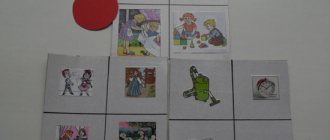Definition of didactics
The word “didactics” is translated from ancient Greek as “educational”. So, when children are taught in an informal play atmosphere, when the child “learns while playing,” experiencing pleasure from the process, this is both a lesson and a game, a didactic game.
A child’s imaginative thinking is directly related to the fact that a little person learns about the world in a playful way.
If you and your child spent the weekend at the zoo, and he was impressed by the orangutan Buba, then get ready for the next few days that all family members will participate in a game called “Buba in the Zoo”.
Imaginative thinking helps a child feel the beauty of the world around him, believe in fairy tales, and develops imagination and creative abilities.
A game for a preschooler is a way of life. And if the game is given an educational focus, then one hundred percent mastery of the material is guaranteed. This is why the didactic game for speech development is so actively used when working with children.
Purpose of the game
Didactic games develop in a child:
- Cognitive skills. The child observes, learns a lot of new things, expands existing knowledge about the world around him, living and inanimate nature.
- Mental capacity. A person learns to think, express his thoughts, construct sentences, reason. And also - remember, compare, evaluate.
- Speech. The vocabulary increases significantly, pronunciation improves, the ability to participate in dialogues and pronounce monologues is formed.
- Moral qualities. The child learns to help, sympathize, restrain himself, and respect others.
- Social adaptation. Skills are acquired such as the ability to conflict, participate in competition, interact with peers, adults, give in to others, and not be offended.
Therefore, if your baby has been asking you to play with him for half an hour, and you have absolutely no time for this, give him a jar of semolina with beans hidden in it, and ask him to prepare dinner for the zoo pets. While you are cooking borscht for dad)).
Types and examples of didactic games for preschoolers
Didactic games differ in content, actions, rules and come in three types:
- games with objects;
- printed board games;
- verbal didactic games.
Their degree of difficulty can be adjusted depending on the age of the participants. The same game can have several variants. For example, kids arrange cards by color; Older children name numbers; and someone can already put the word together.
Games with objects
1. Magic bag
You need to pull out objects of different shapes by touch from the bag: a ball, a cube, a pyramid. Or objects with different textures: pine cone, acorn, chestnut.
2. Rainbow
The child is invited to arrange cubes, mosaics, and pyramids by color.
During didactic games with objects, the child learns to think, analyze, compare objects with each other, he becomes more attentive, his horizons expand, and his fine motor skills improve.
Board-printed games
There is a huge scope for choosing what will be most interesting to your baby at a given time. It can be:
- Pictures for recognition in the form of images, shadows, contours.
- Puzzles.
- Lotto.
- Pictures: find the differences.
- Pictures: pick a pair.
- Labyrinths.
- Designers.
Such didactic games for preschoolers on speech development are interesting and educational. They successfully develop speech skills, logic and imagination, and develop perseverance and patience.
Word games
This type of cognitive communication is very relevant when there are no special objects at hand, so you can use the most familiar things. Here are some examples of such didactic games for the development of speech in preschoolers.
1. Doll
Description of the appearance: color of hair, eyes, clothing items of the fashionable doll.
2. Who is missing?
Place several soft toys nearby. Ask them to close their eyes and remove one. Who can guess: who is missing? We need to name it, tell it what it looks like, figure out where it ran away to.
3. Cube
They roll a dice with pictures on each side. You need to name what is depicted on the top edge and imitate the sound of the object. For example, a steam locomotive. How does the locomotive sound?
4. Catch the ball - name the word that has the opposite meaning. Hot-cold, big-small, close-far.
Verbal games for preschoolers develop speech, reaction speed, correct pronunciation of sounds, expand vocabulary, teach how to construct sentences correctly, and express their thoughts coherently.
What teaching aids can you make yourself for kindergarten?
Language development is not an isolated skill. To a large extent, it is determined by the general level of development of the child and, in particular, his intelligence.
Didactic manual on speech development
Activities that improve sensory and fine motor skills in children are of great importance in this process. For this, it is important to use teaching aids, a significant part of which can be made independently.
Children's learning, especially in junior and middle groups, should take place in a playful environment, otherwise they will lose interest in the subject and time will be wasted. For teaching to be effective, the teacher needs to use all available means to maintain the child’s useful activity.
Didactic materials for sensory development
The “Flower Petals” manual looks like this. A circle is attached perpendicularly to the straight stem. The edges of the central part are covered with Velcro. Several petals with images of objects or fairy-tale characters are offered. This fabric is also attached to the inner edge of each of them. The task is to find the petals with the corresponding words based on the letter drawn on the mug and attach them to the central part.
The game “Blow out the insects into the clearing” is designed to develop speech breathing. For this purpose, the “Polyanka” manual is used. It is a low box with high sides. Small cardboards with images of animals are suspended on short threads from the outside. The child must blow them out, but does not have the right to puff out his cheeks.
Important! In this way he is taught how to breathe correctly during a conversation.
The game "Clothespins" is made using the same manual. For this, the kids are given several colored clothespins and asked to build a fence. They place them on the edges, while loudly calling out the color used.
There are two horizontal lines of Velcro glued to the outer wall of the Polyanka manual. Each row contains four cards with images of animals, fairy-tale characters or objects. The child is told that in each row one of the pictures is extra and is asked to remove it. Then he should tell what the remaining images have in common and why.
Lesson with children
Iconic didactic materials
One of these multifunctional aids is “Teremok”. It is a fabric house attached to a flat, solid base. It has a large number of pockets sewn into it, in which various pictures are placed. They can depict objects of the surrounding world, fairy-tale characters from the fairy tale of the same name, images of letters or syllables.
Formation of coherent speech in children with general speech underdevelopment
There are various ways to use this manual in kindergarten.
Here's one of them. Children are shown pictures taken from a pocket attached to the tower. They ask what fairy tale this hero, who is depicted on the card, came from. The child must remember the name of the fairy tale and try to retell its content.
Important! If the child needs the help of a speech therapist, then it is provided. During the story, the teacher asks the child simple leading questions.
You can also use this manual in a preschool educational institution as follows:
- The teacher takes out cards showing the inhabitants of the tower, but does not show them. He depicts the sounds these animals make. The child must repeat them and name the hero of the fairy tale who is depicted on the card.
- The manual can be used to study prepositions that show the relative position of cards. The teacher places cards with pictures of animals in various pockets and asks questions about who is located where. The child must answer using the prepositions “above,” “under,” or “between.”
- Then the child is asked to formulate questions using the mentioned prepositions and ask them to the teacher.
Another task is the following:
- The child is given cards with images of fairy tale characters and asked to place them in various pockets.
- After this, the kid must say which animal lives on which floor and who is to the left, right, above or below him.
Do-it-yourself didactic games for speech development
Didactic games on speech development can be organized at home, starting from a very young age of your baby. Fine motor skills of fingers in such games will best affect the ability to speak, clearly pronounce words and sounds, and construct sentences.
Didactic games with handmade materials will help preschoolers develop their speech.
Teddy bear and cones
It is very interesting, even for adults, to use tactile sensations in playing with ordinary multi-colored balloons, having previously filled them with various cereals, flour, starch, and pasta. Just don’t inflate them).
Using your imagination, you can act out a scene with a bear collecting cones and balls in a clearing.
After the baby is playing, you can disassemble the basket with “cones”: arrange them by color, crush them and guess the contents.
Puppet show
Really, theatrically, act out your favorite fairy tale. Being the presenter or character, the child will retell the story, or even enthusiastically, on the go, come up with a new plot. You will have no choice but to play along with a serious look, smiling internally and giving warmth to the young talent.
Fabric store
Collect as many scraps of fabrics that differ in texture as possible. The dressmaker daughter will come to the store to buy material for a dress for her doll Dasha. She will definitely touch everything you offer her and choose flowing silk for her ball gown. Don't forget to draw her attention to the buttons: there are so many of them, they are so different. So be prepared for the fact that she may need your advice.
If you don’t have anything at hand, you can quote a line from your favorite poem and ask your child to continue, or remember what it’s about, what it’s called.
The most important thing is that games are communication with a little person who, with our help, begins the journey called “life”. Let's make it unforgettable, joyful, filled with living warmth.
“Place the pebbles in the houses”
The following do-it-yourself teaching aid for kindergarten will help you develop the ability to distinguish colors and name them correctly. The younger group is the target audience for training.
Materials: pebbles, colored cardboard, scissors, glue. Four boxes are made.
Game variations:
- count pebbles of a given color;
- arrange them in appropriate boxes.
The benefit of such a manual is the development of fine motor skills, children learning colors, and the ability to use their names in speech.








